Kingfisher vs kingfisher and American Robin vs Red-tailed Hawk.
Birds attacking other birds is a fairly common phenomenon in nature but it’s unusual for me to actually photograph either the victim or the aggressor during the encounter, in part because birds are so very fast and unpredictable and human reflexes are relatively slow. But two days ago in the mountains it happened twice and I was able to capture at least part of each attack.
Due to a variety of circumstances and conditions many off the following photos are of documentary quality only.
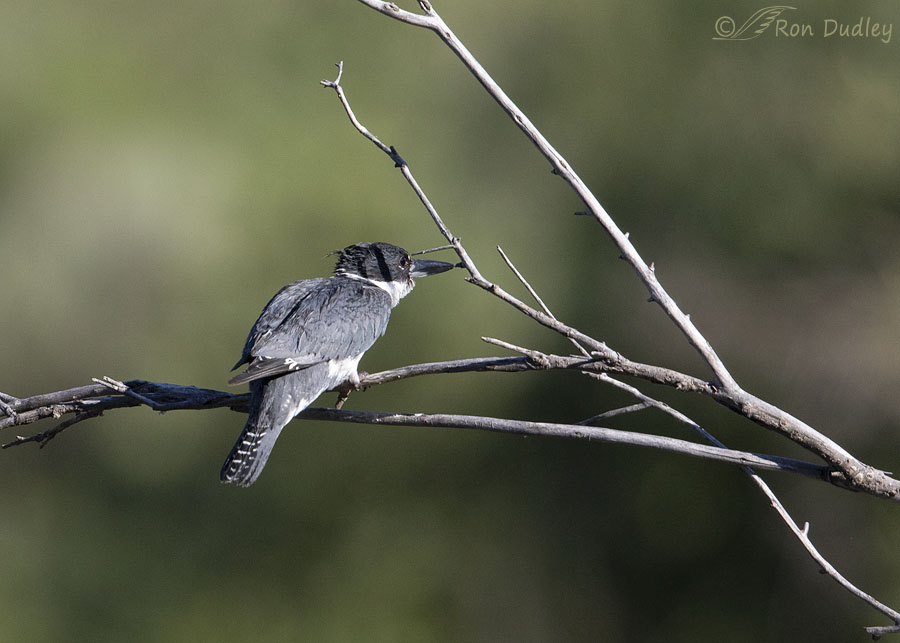
This male kingfisher was minding his own business as I watched him through my lens when I suddenly heard the loud and excited calls of another kingfisher coming in. I had no idea what might be about to happen but I began to fire off a long burst just in case.
During the burst I could see very little of what I was photographing because my shutter curtain was repeatedly blocking my view but I could hear two loud and apparently angry kingfishers. These first five photos are sequential shots in the burst with no skips.
Here we see the beginning of his reaction to the approach of the second kingfisher.
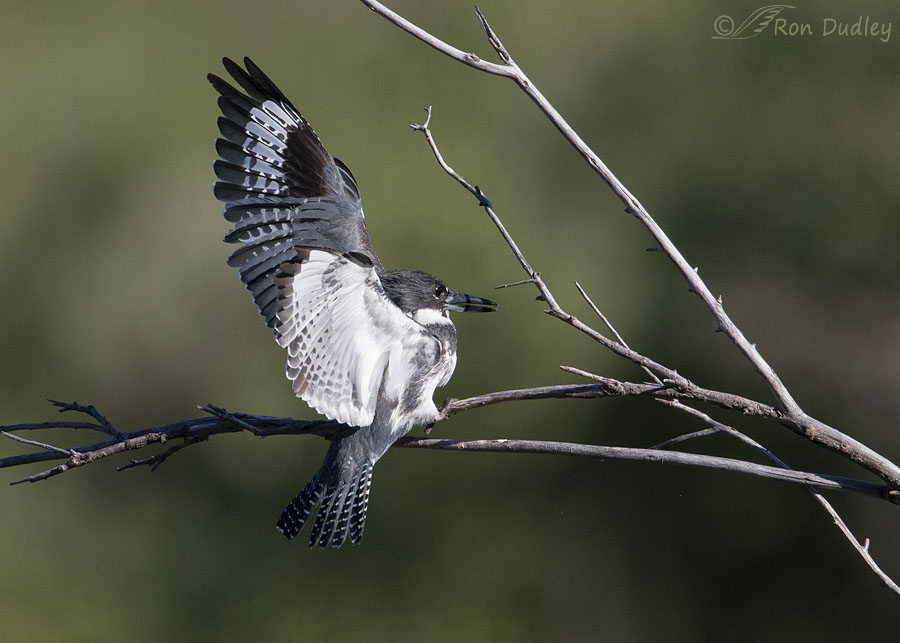
He raised his wings vertically in a pose that I’ve never photographed a kingfisher in before and…
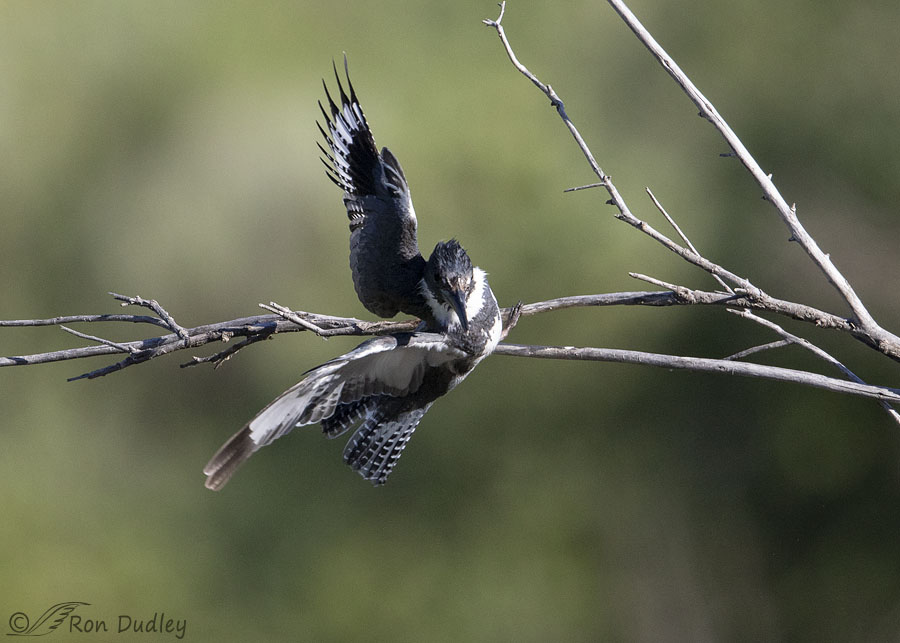
used his stubby little legs and feet to push off of his perch backwards.
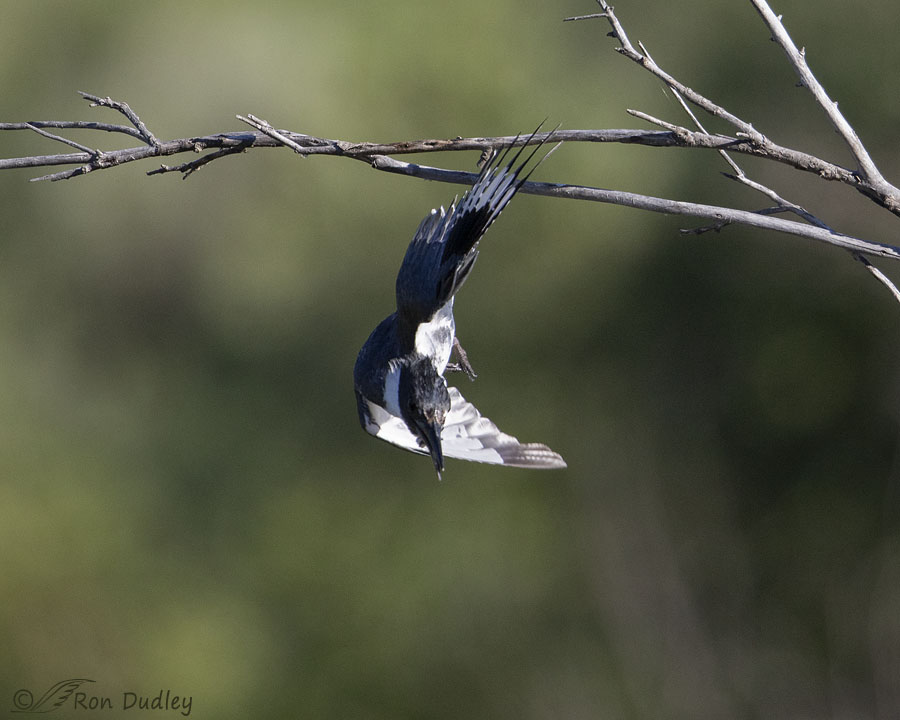
In an effort to avoid the incoming kingfisher his…
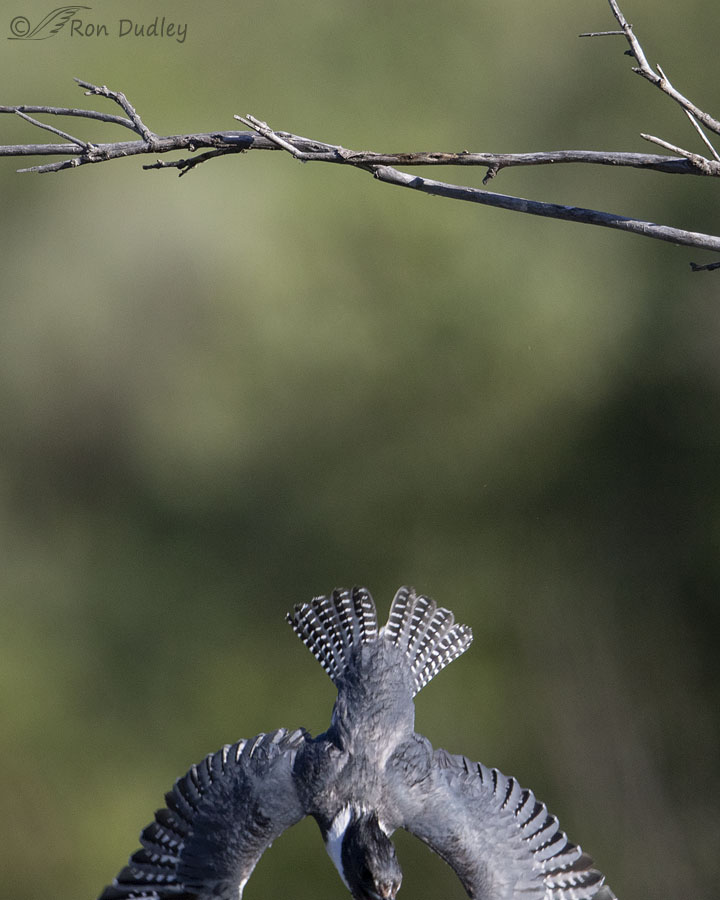
lightning-quick dive was almost perfectly vertical as he exited the frame.
He landed on another nearby perch and it all happened so fast I never did see the attacking kingfisher. There was a juvenile female kingfisher perched nearby but I don’t believe she ever left her perch.
An entire family of kingfishers, including several juveniles, has been hanging out in this area so the aggressor could have been one of them or another kingfisher that was challenging this male for fishing rights. I just don’t know but I’m confident that the aggressor was another kingfisher because I could hear both of them calling loudly and excitedly during the attack.
Much later in the morning as I was about to head home I photographed another aggressive encounter between birds but this time it involved two different species.
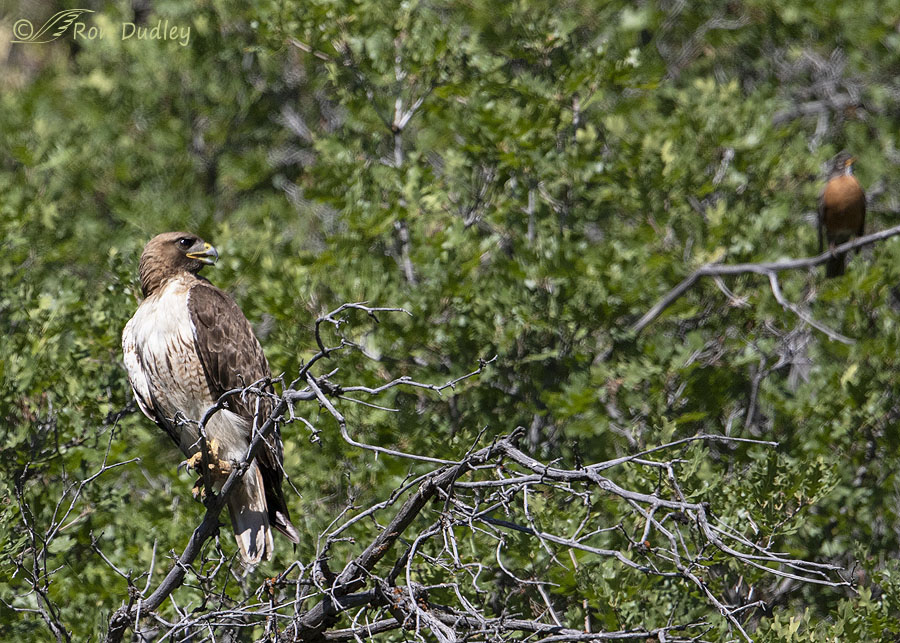
This Red-tailed Hawk was far away but I kept my lens on ‘him’ anyway because I thought he might take off. At first I didn’t notice the robin behind him and to the right but the robin was calling so loudly and excitedly it soon became obvious that it was there and it was far from happy about the hawk’s presence.
Perhaps it had a nest or recently fledged youngsters nearby.
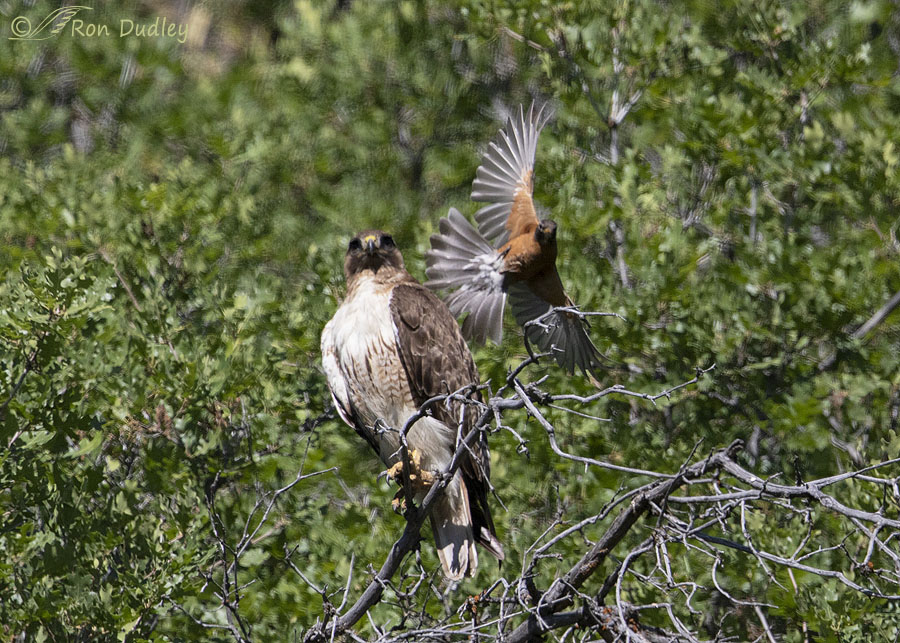
In any case the robin attacked the red-tail by swooping in very close to him when the hawk wasn’t looking.
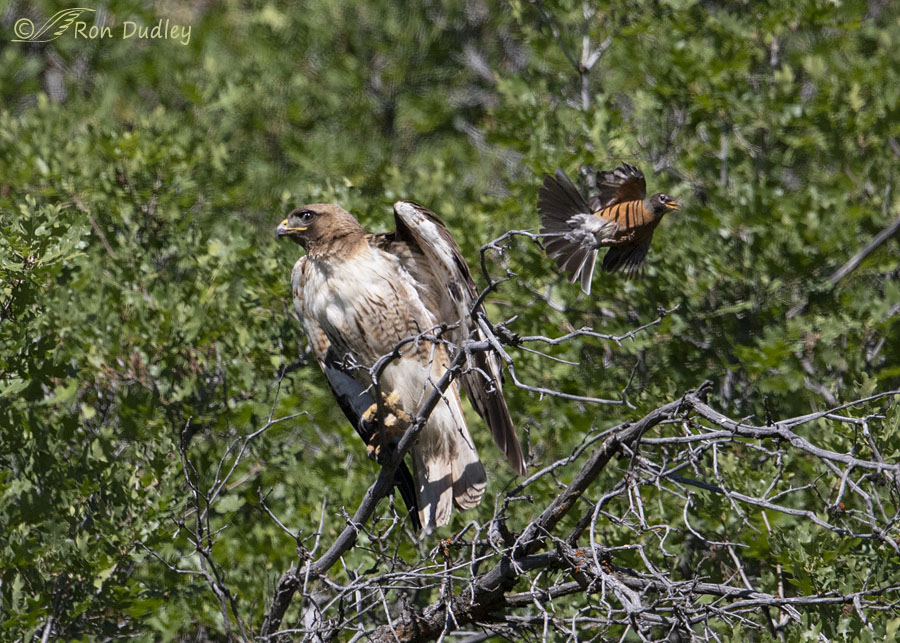
At the last second the robin veered off to the right as the hawk reacted to the attack but he never left his perch.
I have other photos as the robin was approaching the hawk but they’re dreadfully soft because I flinched at the beginning of the attack – yet another rookie mistake on my part. At this focal length (effectively 1120 mm) an unstable lens trained on a far-away stationary subject (the hawk) is a recipe for soft shots.
In this particular case the recipe turned out perfectly but my photos sure as hell didn’t.
Ron


I’m late on this comment as I just got a chance to look at yesterday’s blog. But I really love the photo of the kingfisher with both wings extended above his head. Beautiful detail on both the wing feathers and the tail feathers that is not usually apparent. They are really beautiful birds even if a little understated in their colors.
Gold medals all around for the avian acrobatics (I don’t think they have acrobatics in the Olympics yet) and for the photos “documenting” them (you really are too modest).
Thanks, Lyle. I like these shots a lot as documentary photos but their quality is lacking for anything else.
I made a lot fewer “rookie mistakes” when I was younger and didn’t know any better. 😉
These are amazing shots — documentary or not!
I made a bunch of them when I was younger too, Marty. But back then I actually WAS a rookie. I don’t have that excuse now.
And yes, I join Laura in her longing for bigger, better, brighter superlatives.
🙂
That robin was punching well above its weight.
Documentary shots you say? Education and delight I say.
Education and delight work for me. Thanks, EC.
Fun capture! Good to see you this morning. Did you get good shots this morning? Before you arrived the juvenile was chased by a swallow.
It was great to see you again too, April. It’s been too long since we’ve actually talked.
I managed to get some frame-filling shots of the adult male kingfisher reacting to multiple swallow attacks that I like very much. Don’t think I got the swallow in any of those photos though.
WOW!! What a spectacular set of images! Yes, we all know that redtails are at the tippy top of my favorite-birds list, BUT kingfishers are pretty high up on that list, too, along with robins. Growing up in NE Ohio, robins heralded the approach of spring and that we’d survived another winter. What gorgeous birds kingfishers are and the take-off image is beyond spectacular!! Yeah, yeah, yeah, you’ve got your nits, but to ME, they’re spectacular. (Yes, I know I’ve repeated “spectacular” too many times in too close a space, but that takes us back to the need for a couple hundred more superlatives!)
Right now, local Ithaca, New York folks are trying to keep up with the J-group of Big Red’s and Arthur’s kiddos at Cornell and the double-throw-down easiest way to find them is to follow the cries of the robins and mockers! As you know, redtails (among other raptors) completely disappear among tree leaves, and that’s where the J kiddos are hanging out now–smartly in the cooler shade and mostly quiet until they get hungry! But they can’t hide from robins!
Over the years, I’ve collected FB-posted photos of littler birds attacking bigger birds by riding on the back of their necks in flight, just behind their heads, and attacking more violently from that more stable perch. I’ve got roughly a dozen now, most not really good photos as you would judge them, but certainly documentary! I just posted one of a Kestrel attacking a just-fledged golden eagle on my FB feed if you want to take a look. The Kestrel’s attack is SERIOUS to the golden’s eyes, proving that the little thing (about Kestrels) is not to be taken seriously–EVER! They’re fierce beasties!
Given the realities involved in actually catching these episodes in a camera, I suspect these bombardments happen far more frequently than we know. I mean, somebody like you with the proper expertise has to be in the specific place where it happens at the specific time it happens with a camera capable of capturing the image–plus with the expertise to actually lift the camera and USE it instead of just standing there with your jaw dragging the ground (this would certainly be ME, among all the other factors listed). Aligning all those elements at one time isn’t as easy as it looks, is it? 😉
We falconers call those rookie mistakes “stupid apprentice mistakes.” We need to rename them because they continue to happen, even when one has achieved master status and beyond. The trick is to make fewer of them as time goes on and in falconry, that they don’t result in any injury to the bird–that’s a biggie!!
Oh and I beg to differ 😉 Betting my last bippie again, that’s most likely a female redtail. And since it’s my very last bippie, I’m pretty careful with it. LOL!!
“We need to rename them because they continue to happen, even when one has achieved master status and beyond.”
Laura, I do still make them but I’m encouraged because I make fewer of them as time goes by. While I was photographing that hawk I learned something about getting sharp photos when the bird is that far away with lots of brush and leaves around it. It’s too complicated to explain here but I know I’ll remember it so I believe that will be another rookie mistake I’ll make much less often in the future.
Love the shots and the message!
I wouldn’t call any mistake you make now that you have been a professional photographer for so Loooooog a “Rookie Mistake.” Remember, you are older today than yesterday! I use to be spot on when I was younger, today NOT! We deal with it and move on!
Many thanks for sharing, you and Mia are one of the highlights of my day!!
Thank you, Dick. That’s my point, I’m far from a rookie but I’m still making rookie mistakes.
I just observed an Eastern Kingbird striking and forcing a juvenile Common Grackle into the water of a nearby river. The action happened twice or I would have just thought the juvenile grackle was being clumsy in learning to fly.
Pam, that would have been fun to observe. And photograph, if possible.
These photos, regardless of “image quality,” are really wonderful! I’m especially enamored of the very last, with that Red-tail’s sidewise look at the much smaller robin, like “Really, you just did that?” 😂
Weird, no idea how I ended up replying to your reply to Pam, but there it is….
Thank you, Chris. Sometimes my blog has a mind of its own…
Great catches! Love the vertical wings on the kingfisher; such details in those feathers…never have seen that. It amazes me the lengths smaller birds will go to to protect their young or territory. I’ve seen the relentlessness as they dive with out stretched feet to attempt a hit on the intruder repeatedly…and surprising how a group will come together to attack en masse. Great to be at the right spot ant the right time! 🙂
Kathy, I saw a Barn Swallow repeatedly dive bomb a kingfisher this morning. Haven’t looked at my photos yet but the defensive position of the kingfisher looked pretty neat.
These are great shots, Ron. And you’ve got another Nike of Samothrace with the first one! 🙂
You’re right, Cathy. I do. I didn’t realize it from this angle.
What an exciting post. That posture of the Kingfisher that you have never seen really does appear to be a ready for combat pose. Your Kingfisher story made me realize that in all the years I have seen them around our lakes I have never seen two together or even anywhere near each other.
I just experienced the very same robin behavior with a male Great Horned Owl. I heard loud noises coming from the trees around a riparian pond and I knew right away what it was. Hustled over there and saw the two robins doing exactly what your photos with the hawk showed. They flew back and forth actually hitting the owl in the face time after time. His mouth was open and he was angry and would try to grab them with his beak, but never raised up to use his talons. This went on for a half hour before I finally left. He never left, just endured this for the whole time, and the robins of course were protecting their nest so they were going to continue no matter how long it took.
Excellent photos of both incidents.
Those Robins will keep it up all day long! Have it happen fairly often when the GHO’s come in to roost “too late” and the Robin’s spot them. GEEZ!
Everett, I don’t see them in groups often either but for a while after their chicks have fledged the parents still feed the youngsters so they tend to stay fairly close to each other. I saw two together this morning and heard another one nearby.
WOW! What a great shot of the Robin after the Hawk! Glad you caught some the the action as well as the Kingfisher vacating his perch. It DOES happen SO fast and which way they’g going to go is often unpredictable. 🙂 Often the smaller the bird the more aggressive they are with HUGE birds – watch them give Eagles and Hawks hell regularly actually hitting them!
Thank you, Judy.
What amazing photos! Very exciting and nothing I’ve ever seen with this detail. The beauty of the kingfisher’s feathers is exceptional. I also really enjoy imagining what the look in the hawk’s eye in the last photo means. Brave robin!
Brave robin indeed. Thanks, Mary.